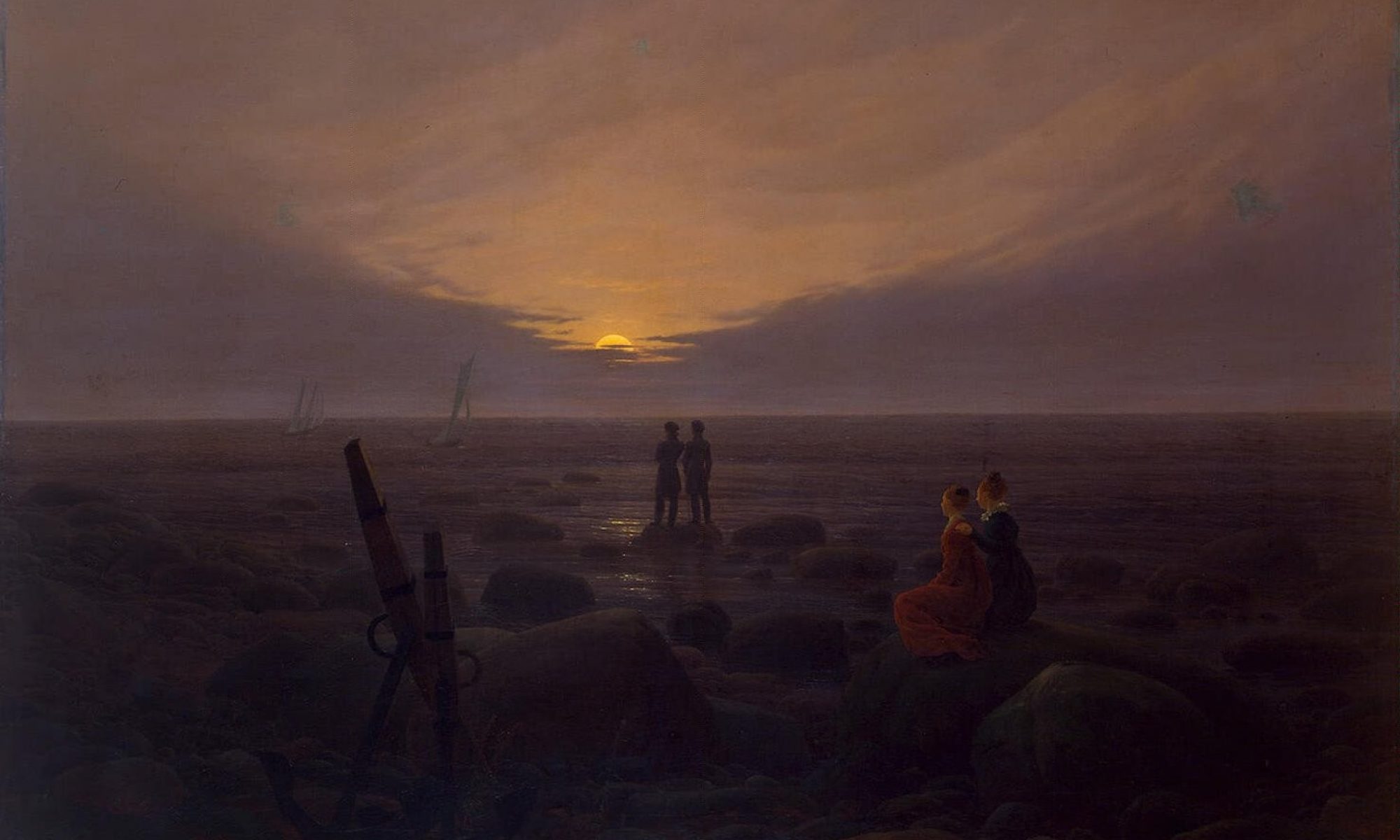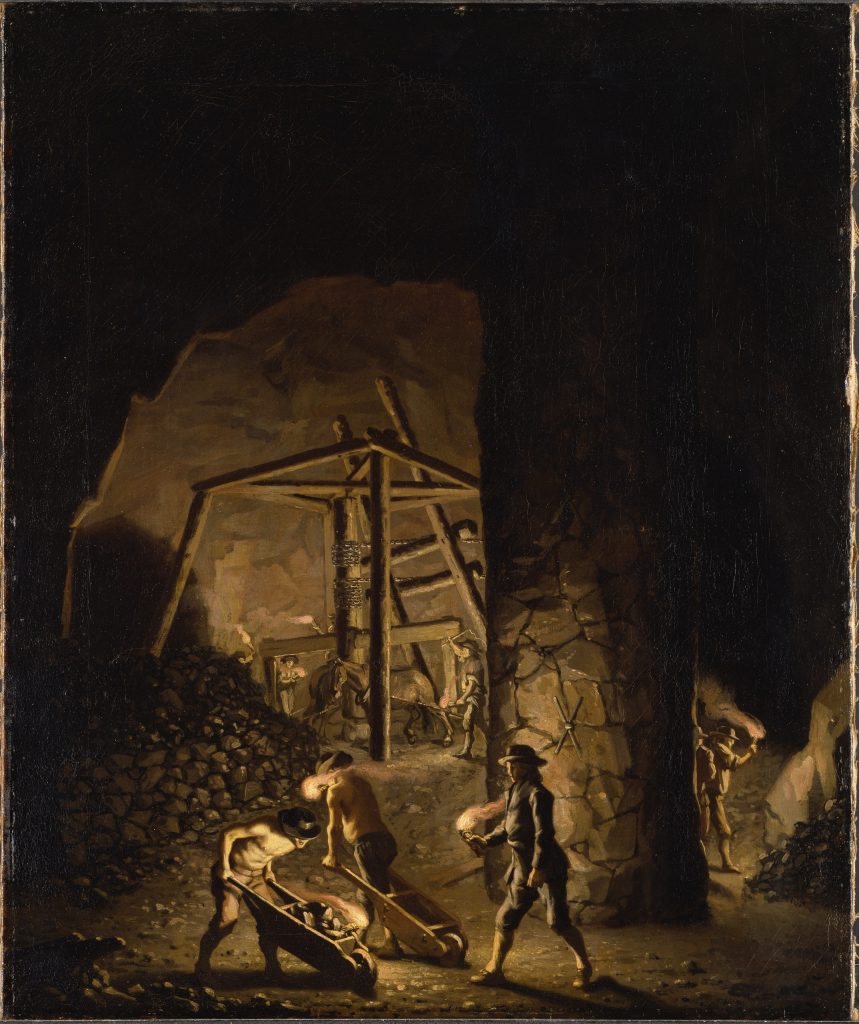Contributor: Cian Duffy
Location: Falun, Sweden (60°35.56N’ 15°36.44’E)
Description: Declared a UNESCO World Heritage site in 2001, Falun Mine, in Dalarna, Sweden, was, during the eighteenth century, one of the largest copper mines in Europe and a key locale for the development of mining technology. Many British Romantic-period travellers to Sweden wrote about visits to the mine and descents into its depths, although not Mary Wollstonecraft (1759-97). Swedish visitors of note included the theologian and mystic Emanuel Swedenborg (1688-1772) and the natural philosopher Carl Linnaeus (1707-78). However, Falun is probably now best known to scholars of the Romantic period as the setting for E.T.A. Hoffmann’s (1776-1822) story ‘Die Bergwerke zu Falun’ [The Mines at Falun] (1819), which Theodore Ziolkowksi, in his pioneering study German Romanticism and Its Institutions, describes as the ‘culmination’ of ‘the obsession with mines’ in German Romantic-period cultural texts (p. 55).
There is archaeological evidence of excavations at Falun from c. 1000 CE. In his Travels into Poland, Russia, Sweden and Denmark (1792), William Coxe (1748-1828) affirms the ‘great antiquity’ of the mine (vol. 5, p. 93), although Edward Daniel Clarke (1769-1822), who visited in 1799, sounds a more sceptical note in his Travels in Various Countries in Scandinavia (1838), suggesting that ‘if any credit might be given to the traditions extant concerning it, all the copper employed by Solomon, in building the Temple at Jerusalem, was derived from the Fahlun mine’ (vol. 2, pp. 526-7).
Coxe’s description of Falun is comparatively brief: he records that his party ‘descended as far as we could penetrate’ into the ‘immense chasm’, compares the miners ‘to the Cyclops’ whom Greek myth placed in the forges of Hephaesthus beneath Etna, and recalls ‘the sublimity of those tremendous sounds formed by the explosions of gunpowder, circumstances common to all mines and not peculiar to this of Fahlun’ (vol. 5, pp. 96-7). Clarke’s account of this ‘scene of so much fearful grandeur’ is considerably more detailed, running to almost forty pages (vol 2., p. 520). He and his companions ‘were four hours diligently employed in the examination of the principal excavations’ (vol. 2, p. 532). Like Coxe, Clarke draws on the aesthetics of the sublime to convey the ‘very striking’ scene, describing the ‘intolerable’ heat and making repeated comparisons with Vesuvius and the volcanic landscapes around Naples (vol. 2, pp. 538), which he had visited on an earlier journey. But Clarke is also concerned with the insights into natural philosophy which the mine provides, noting that the head of the mine, the ‘celebrated’ Swedish chemist and metallurgist Johan Gottlieb Gahn (1745-1818), had made some ‘very remarkable’ ‘discoveries’ which ‘entitled him to respect and consideration in all the Academical Institutions of Europe’ (vol. 2, pp. 527-8). Discoveries made through mining played a key role in the development during the late eighteenth and early nineteenth centuries of the modern, professional discipline of geology out of the earlier practice of natural philosophy. The German Abraham Gottlob Werner (1749-1817), for instance, who led the Freiberg Mining Academy, was one of the most most influential proponents of the so-called ‘Neptunist’ position in the Romantic-period geological debate about whether water or volcanic activity was the primary agent of geomorphic change; the rival ‘Plutonist’ position, notably propounded by the Scottish geologist James Hutton (1726-97) proved, of course, to be correct. Clarke also notes the ‘old custom [..] that every Swedish king should once, at least, during his reign, pay a visit to Fahlun, and descend into this mine’ (vol. 2, p. 541).
Hoffmann’s story recounts the fate of a sailor-turned-miner named Elis Fröbom who is led to Falun by a mysterious old miner, later identified as a semi-legendary figure known to the local community as Torbern, who had died during the collapse of the mine on Midsummer’s Eve, 1687. This collapse actually occurred and is described by Clarke, who misdates it to 1666 (vol. 2, p. 533). Fröbom makes a great success of his career and falls in love with Ulla Pehrson Dahlsjö, whose father is a major shareholder in the mine. But Fröbom becomes increasingly obsessed by a mysterious female power whom he sees in visions and to whom he attributes his success as a miner, and whom Torbern calls ‘the Queen’. On the morning of his marriage to Ulla, on Midsummer’s Eve, Fröbom goes to the mine to seek a precious stone from the Queen to give to his bride. A collapse occurs and he is presumed dead. Fifty years later, again on Midsummer’s Eve, two miners discover his body, perfectly preserved in vitriol. They bring it to the surface, where it is recognised by Ulla, who has compulsively returned to Falun on that same day each year. She dies and Fröbom’s body begins to decay. Both are buried in the local church, where they meant to marry.
As scholars have long recognised, Hoffmann drew the denouement of his tale from the fate of Mats Israelsson, colloquially known as Fet-Mats [Fat Mats], a miner at Falun who disappeared during an accident in 1677. Israelsson’s body was discovered in 1719, preserved in vitriol, and subsequently identified by his former fianceé Margaret Olsdotter. The case was much discussed at the time, including by Linnaeus, who visited Falun in the summer of 1734. Curiously, neither Clarke nor Coxe nor a number of other Romantic-period British visitors to Falun mention it, but the story evidently still had some currency in popular and scientific British periodicals in the early nineteenth century, and it features in, for example, The Philosophical Transactions of the Royal Society (vol. 7; 1809), The Literary Panorama (vol. 8; 1810), and The Universal Magazine (vol. 21; 1814). It seems to have retained greater visibility in German, possibly because German was more widely spoken than English in Sweden at the time. As late as 1808, the German natural philosopher Gotthilf Heinrich von Schubert (1780-1860) discussed the case in his Ansichten von der Nachtseite der Naturwissenschaft [Perspectives from the Dark Side of Natural Philosophy] (pp. 215-6), and the poets Johann Peter Hebel (1760-1826) and Ludwig Achim von Arnim (1781-1831) both engage with it.
Hoffmann’s story, which inspired a libretto by Richard Wagner (1812-83), has often been read in symbolic terms, as narrating what Ziolkowski calls ‘the descent into sexuality’, into ‘the sinful knowledge of sensuality, which leads to madness and death’ (pp. 49, 57). But for all its symbolic charge, Hoffmann’s imagery is also very much informed by contemporary debates in natural philosophy about the agencies of geomorphic change and by speculation about the mineralogical and metallurgical composition of the earth.
Date: documented excavations from c.1000 CE; closed 1992.
Creator: countless generations of miners
Media: Pehr Hilleström (1732-1816), Nedre bergmästarorten i Falu Gruva [Lower Gallery in Falu Mine] (date unknown), oil on canvas, 79cm x 65.5cm.
Media rights: Wikimedia Commons (https://commons.wikimedia.org/wiki/File:Gallery_in_Falun_Copper_Mine_(Pehr_Hillestr%C3%B6m_d.%C3%A4.)_-_Nationalmuseum_-_23800.tif). Original at Nationalmuseum, Stockholm (Sweden).
Object type: copper mine; closed 1992.
References
William Coxe, Travels into Poland, Russia, Sweden, and Denmark, fourth edition, 5 vols. (London, 1792).
Edward Daniel Clarke, Travels in various Countries in Scandinavia, 3 vols. (London, 1838).
E.T.A. Hoffmann, ‘Die Bergwerke zu Falun’, in Die Serapionsbrüder (Berlin, 1819).
Gotthilf Heinrich von Schubert, Ansichten von der Nachtseite der Naturwissenschaft (Dresden, 1808).
Theodore Ziolkowski, German Romanticism and Its Institutions (Princeton UP, 1990)

